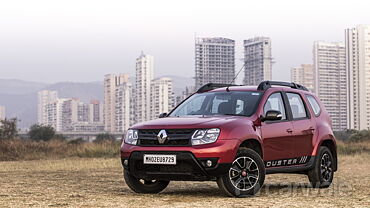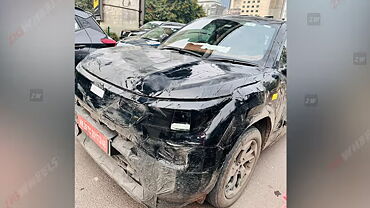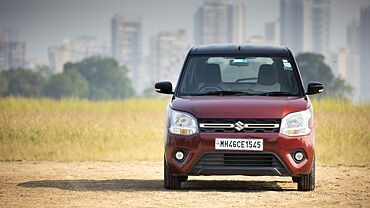
India is a seeing a growth in demand for petrol powered vehicles and manufacturers are introducing the options across price points. The latest to join the fray are the mid-size SUVs. However, as quickly as the demand has grown, the nature of what the consumer wants has also changed. It is not just petrol vehicles that people want, they are now demanding petrol automatics across all body styles. Stepping up to the plate in a fast growing part of the market are petrol AT SUVs - a segment which, until recently, had only the Hyundai Creta. It has now been joined by the Renault Duster which has been fitted with a new petrol engine and a CVT. How does the new boy match up to the established player? Read on to find out.
Exterior
The Renault Duster in this petrol CVT variant gets a two-tone fascia, contrast coloured mirrors and stickers on the side to denote the CVT nature of the car. In contrast, the Creta is a bit more subtle. Its AT feature is only understood when one looks at the badging on the rear hatch. However, given the Duster’s quirky and funky looks, it is definitely a better attention seeker than the Hyundai Creta.
Features
While the Duster may have won the battle on the outside, the Creta clearly takes the victory here as the AT option is only offered in a top-of-the-line SX variant whereas the Duster CVT can be had only in the mid-level RXS trim level.
There is a Rs 2.7 lakh difference between the vehicles and the higher priced Hyundai clearly seems to show its worth for the extra cash. You get traction control, speed sensing door locks, climate control, touchscreen system, passenger airbag, seat height adjustment driver arm rest, dual tone interiors, front adjustable head rests , one-touch driver window, chrome door handles , boot lid opener on key, chrome finish exhaust pipe and projector head lamps. It also beats the Duster in terms of warranty as it has a 3year/unlimited warranty as compared to the former’s 2years/50,000km. However, despite the variant difference, the Duster is longer and has a bigger wheelbase, making it more spacious a somewhat less feature heavy option than the petrol AT Creta.
Now given that there is demand for such vehicles, we believe that Renault will at some point introduce an RXZ variant for the Duster CVT. This has all the features that the Creta in the SX variant offers and will be priced quite similarly.
Engine and gearbox
This petrol AT Duster is mated to a 1.5-litre four-cylinder petrol mill producing 105bhp/142Nm while the Creta gets a 1.6-litre four-cylinder engine that produces 122bhp/154Nm. The French car gets a CVT while the South Korean has been fitted with a six-speed AT.
Conclusion
The basic concept of both vehicles may be the same but the Creta clearly has the upper hand as it is the more expensive of the two and clearly the extra cost gets you a lot of kit. But if you are willing to compromise on features and want to buy a car with just the intention of getting an automatic C-segment SUV then the Duster is the better of the two.

![Hyundai Creta [2017-2018] Image Hyundai Creta [2017-2018] Image](https://imgd.aeplcdn.com/272x153/cw/ec/19382/Hyundai-Creta-Right-Front-Three-Quarter-118797.jpg?wm=0&q=80)
![Renault Duster [2016-2019] Image Renault Duster [2016-2019] Image](https://imgd.aeplcdn.com/272x153/cw/ec/22446/Renault-Duster-Exterior-118973.jpg?wm=0&q=80)















![Hyundai Creta [2017-2018] Right Front Three Quarter Hyundai Creta [2017-2018] Right Front Three Quarter](https://imgd.aeplcdn.com/199x112/cw/ec/19382/Hyundai-Creta-Right-Front-Three-Quarter-118797.jpg?wm=0&q=80)
![Hyundai Creta [2017-2018] Right Front Three Quarter Hyundai Creta [2017-2018] Right Front Three Quarter](https://imgd.aeplcdn.com/199x112/ec/33/33/19382/img/ol/Hyundai-Creta-Right-Front-Three-Quarter-54590.jpg?v=201711021421&q=80)
![Hyundai Creta [2017-2018] Right Front Three Quarter Hyundai Creta [2017-2018] Right Front Three Quarter](https://imgd.aeplcdn.com/199x112/ec/33/33/19382/img/ol/Hyundai-Creta-Right-Front-Three-Quarter-54597.jpg?v=201711021421&q=80)
![Hyundai Creta [2017-2018] Dashboard Hyundai Creta [2017-2018] Dashboard](https://imgd.aeplcdn.com/199x112/ec/33/33/19382/img/ol/Hyundai-Creta-Dashboard-54628.jpg?v=201711021421&q=80)
![Hyundai Creta [2017-2018] Dashboard Hyundai Creta [2017-2018] Dashboard](https://imgd.aeplcdn.com/468x263/cw/ec/19382/Hyundai-Creta-Dashboard-99466.jpg?v=201711021421&wm=1&q=80)



























